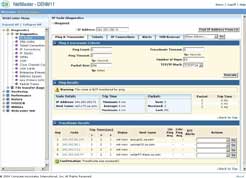In-Depth
Perspective: Overcoming the Six Challenges of Managing Mainframe Connectivity
Last week we presented six key challenges network managers face. This week we explore how vendors are helping managers overcome these challenges.
- By Warren Jones
- 05/11/2004
Last week I highlighted some of the challenges we faced when managing mainframe connectivity (see
Perspective: Six Challenges of Managing Mainframe Connectivity). In this part I want to focus on some areas mainframe network management products are headed to assist you in overcoming these challenges.
Continuous Monitoring
More than likely, the management product you rely on today gathers data by sampling MIB data on a periodic basis. This in itself is not a bad thing, but it can be complemented with additional data. Taking a different approach, some products are recently starting to collect performance data by sitting on the mainframe stack and watching the actual IP packet flow. The greater granularity that this provides makes it possible to identify peaks and troughs that may otherwise be hidden by the sampling approach. This not only provides us with more granular performance data, but also provides additional information that can be further exploited and analyzed to identify "real" problems in your network.
It is this second phase that really excites me. For example, we could analyze ICMP (Internet Control Message Protocol) traffic. ICMP deals with network-related rather than data-related levels of traffic. Analysis of ICMP traffic may lead to early warning situations related to subnetworks/hosts/interfaces/stacks leaving/joining the monitored network, as well as traffic path changes. It would enable more intelligent understanding of the network topology and its changes and problems. If the critical elements of the network are defined, status changes would provide early warnings and detection of problems.
Self Management
Self management is a key enabling function associated with On-demand computing. There are two facets of self management: easy administration and self-defining service levels via automated discovery.
Focusing solely on the second aspect of self management, making sense of the multitude of management information presented from management products is problematical. What needs to happen is our management products need to remove some of the onus from the user in terms of comprehending this information. One thing that many distributed network management products do, and we are now starting to see implemented in mainframe-based solutions, is baselining. In baselining, the management product is aware of what is normal network activity. Meaningful baselines are typically calculated based on time of day; "n" day rolling averages; or day of the week. With this baseline knowledge you can look for deviations from the norm and highlight problems based on exceptions.
Web-browser-based User Interfaces
As we all deal with the "do more with less:" decree. In the mainframe area we are also challenged with having an aging -- I like to say "maturing" -- resource pool. In addressing this challenge mainframe management products need to adopt interfaces that open up the mainframe to be administered by personnel who may not necessarily have a large amount of knowledge of the mainframe management environment. A trend that has been occurring for a few years now is the provision of Web-browser-based user interfaces.

This type of interface provides an interface that is readily understood by most computer users, taking advantage of features (such as drop-down lists, navigation trees, scroll bars, and multiple windowing) that assist in simplifying operations. The figure (right) highlights an example of Computer Associates’ Unicenter NetMaster user interface.
Application Relevance
Forever more, the network will be intrinsically linked with the applications that are being accessed through it. Applications such as CICS, DB2, WebSphere, and WebSphere MQ (to name but a few) dictate that the network operator has some appreciation for the application as well as the network connections to them. Often when a problem occurs, the network is guilty until proven innocent. Without adequate knowledge of what is happening at the application level, network operators are left chasing their tails.
Being able to associate a network connection with the work being performed on its behalf in the application provides the operator with the necessary information to determine whether the responsibility lies with the application or the network. Furthermore it allows the operator to pass on meaningful and timely information to the system or application people when the application is determined to be at fault.
Summary
This is by no means an exhaustive list of the challenges faced by network professionals in managing their mainframe-based network. I hope the challenges discussed have been met with "knowing nods." These are the challenges that management products must ultimately address.
Just like our networks, management products are also evolving. I see more mature network management products on the horizon, and they need to move from being data collectors to providing legitimate analysis and automation functions.
Exciting times lie ahead, and I hope you find some solace in the fact that help is on its way.
About the Author
Warren Jones is Product Manager, Unicenter Mainframe Network Management products at Computer Associates International. He is responsible for all aspects of product management for several of CA’s mainframe products, including Unicenter NetMaster Network Management for TCP/IP. A native of Australia, Jones holds a Bachelor of Business degree from University of Western Sydney.